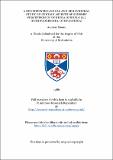Files in this item
A neurophysiological and behavioural study on certain aspects of sensory perception in 'Ophiura ophiura' (L.) (Echinodermata, Ophiuroidea)
Item metadata
| dc.contributor.advisor | Cobb, James L. S. | |
| dc.contributor.author | Moore, Andrew | |
| dc.coverage.spatial | 117 p. | en_US |
| dc.date.accessioned | 2018-06-25T14:42:49Z | |
| dc.date.available | 2018-06-25T14:42:49Z | |
| dc.date.issued | 1986 | |
| dc.identifier.uri | https://hdl.handle.net/10023/14553 | |
| dc.description.abstract | Electrophysiological recordings were made from the radial nerve cord of the brittlestar Ophiura ophiura in response to stimulation by certain environmental parameters. Extracellular suction electrodes attached to the ectoneural portion of the radial nerve cord recorded unitary potentials in response to photic, mechanical and chemical stimulation. O. ophiura is highly sensitive to reductions in the ambient light level or shadow, the greatest response being to the rapid onset of a dense shadow on the tip of the arm. Parallel behaviour studies indicate that this same stimulus resulted in the cessation of any type of activity in the unrestrained animal. The "freezing" of the brittlestars movements at the onset of such a shadow stimulus, is suggested to be a means of escaping detection by a predator. The range that the brittlestar is able to detect in the mechanical mode extends from the nearfield of a vibrating source, through the far field propagated pressure wave, to movement of the aquatic medium as a whole in the form of water currents. The behavioural responses of unrestrained animals to stimulation in the same frequency range is described. The presence of an interoreceptor located within the spines, which is responsible for some mechanical sensitivity is inferred from electrophysiological recordings in response to the movement of individual arm spines. Using neurophysiological techniques, O. ophiura could be shown to detect consistently a range of amino acids at concentrations as low as 2 X 10<super>-12</super>M. as in the case of L-Leucine. Parallel behaviour experiments were inconsistent and indicate the inadequacies of using behavioural criteria to demonstrate the sensory discriminatory abilities of echinoderms. An anatomical study of the podia, spines and general surface of O. ophiura using the scanning and transmission electron microscopes, describe various types of ciliated cells which may function as receptors. The relationship of these structures to the sensory abilities of the brittlestars detected physiologically is described. | en_US |
| dc.language.iso | en | en_US |
| dc.publisher | University of St Andrews | |
| dc.subject.lcc | QL384.O6M7 | en |
| dc.subject.lcsh | Ophiuroidea | en |
| dc.title | A neurophysiological and behavioural study on certain aspects of sensory perception in 'Ophiura ophiura' (L.) (Echinodermata, Ophiuroidea) | en_US |
| dc.type | Thesis | en_US |
| dc.type.qualificationlevel | Doctoral | en_US |
| dc.type.qualificationname | PhD Doctor of Philosophy | en_US |
| dc.publisher.institution | The University of St Andrews | en_US |
This item appears in the following Collection(s)
Items in the St Andrews Research Repository are protected by copyright, with all rights reserved, unless otherwise indicated.

